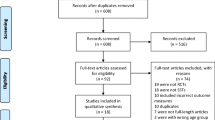Abstract
Sensory processing disorder (SPD) is a disruption in the organization of sensory input, and affects up to three million children in the United States. SPD can have a serious impact on the ways that children behave, play, and learn, and yet, it may be overlooked or misunderstood by social work practitioners. The purpose of this article is to inform social work practice regarding SPD, strengthening the biological component of biopsychosocial assessment. After an introduction to the disorder, this article discusses differential diagnosis and practice implications, and concludes with a statement on interdisciplinary treatment.
Similar content being viewed by others
References
Ahn, R. R., Miller, L. J., Milberger, S., & McIntosh, D. N. (2004). Prevalence of parents’ perceptions of sensory processing disorders among kindergarten children. American Journal of Occupational Therapy, 58, 287–293.
American Psychiatric Association. (2000). Diagnostic and statistical manual of mental disorders (4th ed., Text Rev.). Washington, DC: Author.
Ayres, A. J. (1979). Sensory integration and the child. Los Angeles: Western Psychological Services.
Ayres, A. J. (1996). Sensory Integration Praxis Test. Los Angeles: Western Psychological Services.
Byrne, M. W. (2009). Sensory processing disorder: Any of a nurse practitioner’s business? Journal of the American Academy of Nurse Practitioners, 314–321.
Cantu, C. O. (2003). OT in public schools: A 2003 review and prospectus. The Exceptional Parent, 33(9), 136–140.
Champagne, T., Koomar, J., & Olson, L. (2010). Sensory processing evaluation and intervention in mental health. OT Practice, 15 (5), CE-1–CE-7.
Davies, P. L., & Gavin, W. J. (2007). Validating the diagnosis of sensory processing disorders using EEG technology. The American Journal of Occupational Therapy, 61, 176–189.
Dunn, W. (1997). The impact of sensory processing abilities on the daily lives of young children and their families: A conceptual model. Infants and Young Children, 9, 23–35.
Dunn, W., Miller, L. J., & Shyu, V. (2002). Sensory Profile. San Antonio: PsychCorp.
Epstein, R. (1998). Getting insurance to cover various therapies. The Exceptional Parent, 28(7), 75–77.
Kern, J. K., Trivedi, M. H., Granneman, B. D., Garver, C. R., Johnson, D. G., Andrews, A. A., et al. (2007). Sensory correlations in autism. Autism, 123-134.
Koziol, L. F., Budding, D. E., & Chidekel, D. (2011). Sensory integration, sensory processing, and sensory modulation disorders: Putative functional neuroanatomic underpinnings. Cerebellum, 10, 770–792.
Kranowitz, C. S. (2005). The Out of Sync Child: Recognizing and Coping with Sensory Processing Disorder. London: Skylight Press.
Miller, L. J., Nielsen, D. M., Schoen, S. A., & Brett-Green, B. A. (2009). Perspectives on sensory processing disorder: A call for translational research. Frontiers in Integrative Neuroscience, 3, 1–12.
Miller, L. J. (2012, December 3). Final Decision for DSM-V. Retrieved December 19, 2012, from Sensory Processing Disorder Foundation: http://spdfoundation.net/sensory-processing-blog/2012/12/05/final-decision-for-dsm-v/.
Morris, M. (2011). Age of Onset of SPD. Retrieved January 29, 2011, from Sensory Processing Disorder: http://www.sensory-processing-disorder.com/age-of-onset-of-spd.html.
Mulligan, S. (1996). An analysis of score patterns of children with attention disorders on the Sensory Integration and Praxis Tests. American Journal of Occupational Therapy, 50, 647–654.
Parham, L. D., & Ecker, C. (2007). Sensory Processing Measure. Los Angeles: Western Psychological Services.
Reeves, G. D. (1998). Case report of a child with sensory integration dysfunction. Occupational Therapy International, 5, 304–317.
Reynolds, S., & Lane, S. J. (2007). Diagnostic validity of sensory over-responsivity: A review of the literature and case reports. Journal of Autism and Developmental Disorders. doi:10.1007/s10803-007-0418-9.
Schneider, M. L., Moore, C. F., Gajewski, L. L., Larson, J. A., Roberts, A. D., Converse, A. K., et al. (2008). Sensory processing disorder in a primate model: Evidence from a longitudinal study of prenatal alcohol and prenatal stress effects. Child Development, 100–113.
Schneider, M. L., Moore, C. F., Gajewski, L. L., Laughlin, N. K., Larson, J. A., Gay, C. L., et al. (2007). Sensory processing disorders in a non-human primate model: evidence for occupational therapy practice. The American Journal of Occupational Therapy, 61, 247–253.
Schoen, S. A., Miller, L. J., Brett-Green, B., & Hepburn, S. L. (2008). Psychophysiology of children with autism spectrum disorder. Research in Autism Spectrum Disorders, 417-429.
Sensory Processing Disorder Checklist: Signs and Symptoms of Dysfunction. (2008). Retrieved March 19, 2013, from Sensory Processing Disorder: http://www.sensory-processing-disorder.com/sensory-processing-disorder-checklist.html.
Strzelecki, M. V. (2008). Moving forward: A look at Sensory Integration. OT Practice, 17-21.
Tomchek, S. D., & Dunn, W. (2007). Sensory processing in children with and without autism: A comparative study using the short sensory profile. The American Journal of Occupational Therapy, 61, 190–200.
Ungerstedt, U., & Ljungberg, T. (1974). Central dopamine neurons and sensory processing. Journal of Psychiatric Research, 11, 149–150.
United States Census Bureau. (2008). Annual Estimates of the Resident Population by Sex and Selected Age Groups for the United States: April 1, 2000-July 1, 2008. Washington, DC: http://www.census.gov/popest”vagaltone”. (2004). Retrieved October 27, 2009, from encyclopedia.com:http://www.census.gov/popest.
Wallis, C. (2007a). Is this disorder for real? Time, 170, 62–66.
Wallis, C. (2007, November 29). The next Attention-Deficit Disorder? Retrieved March 8, 2013, from http://www.time.com/time/magazine/article/0,9171,1689216-2,00.html.
Author information
Authors and Affiliations
Corresponding author
Rights and permissions
About this article
Cite this article
Walbam, K.M. The Relevance of Sensory Processing Disorder to Social Work Practice: An Interdisciplinary Approach. Child Adolesc Soc Work J 31, 61–70 (2014). https://doi.org/10.1007/s10560-013-0308-2
Published:
Issue Date:
DOI: https://doi.org/10.1007/s10560-013-0308-2




